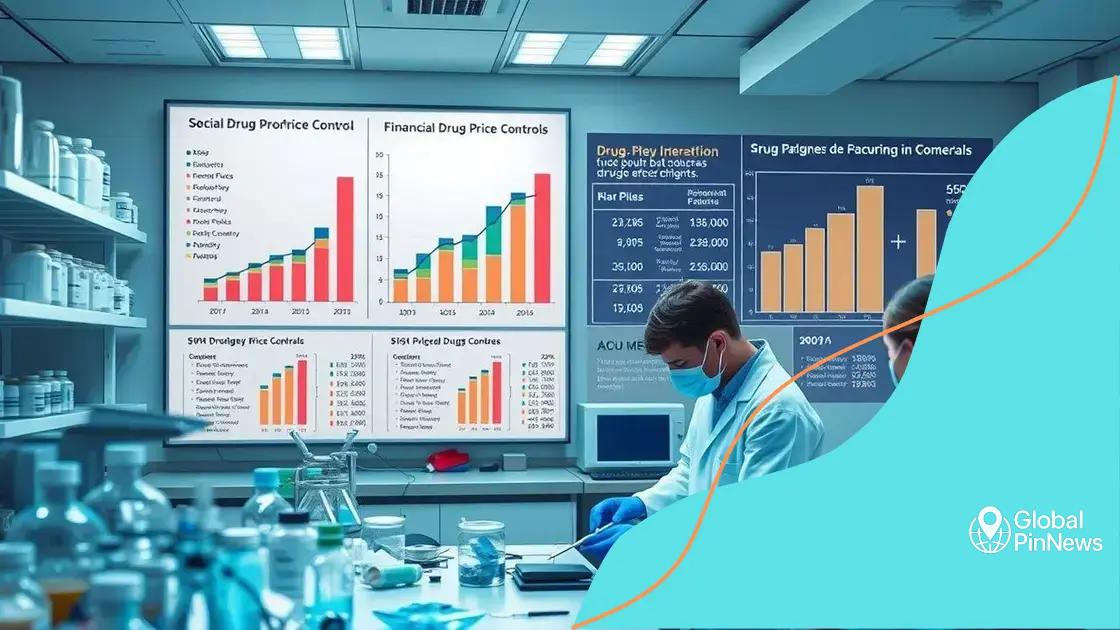Progress on prescription drug price controls: what you need to know

Progress on prescription drug price controls aims to make medications more affordable for consumers while balancing the need for pharmaceutical innovation and ensuring a sustainable healthcare system.
Progress on prescription drug price controls is ongoing, and it’s a hot topic these days. Have you ever wondered how these changes could affect your wallet and access to medications? Let’s dive into what’s happening.
The current state of prescription drug prices
The current state of prescription drug prices remains a pressing concern for many people. Rising costs have been highlighted in news reports and discussions among policymakers. Understanding how these prices are set and the factors affecting them is essential for consumers and advocates alike.
Factors Influencing Drug Prices
Various factors contribute to the price of prescription medications. These can include:
- Research and development costs
- Market demand for specific drugs
- Patents and exclusivity rights
- Negotiation strategies by pharmacies and insurers
As prices continue to fluctuate, many are searching for ways to gain access to affordable medications. The importance of transparency in drug pricing cannot be overstated. Many consumers feel confused about why certain drugs are priced so high, especially when generic alternatives exist.
The Role of Insurance
Insurance plans also significantly impact the costs that patients face. Depending on the coverage, a patient may pay a lower or higher price for their medications. Understanding their insurance plan can help consumers make informed decisions, and in some cases, reduce their overall health expenses.
It is crucial to keep advocating for fair pricing and better access to medications. As conversations around healthcare reform evolve, the spotlight on prescription drug prices will likely intensify, making it vital for consumers to stay informed and engaged.
Recent legislation on drug price controls
Recent legislation regarding drug price controls has gained significant attention as lawmakers work to address the growing concern over escalating medication costs. Various policies aim to make prescriptions more affordable for consumers while balancing the needs of pharmaceutical companies.
Key Legislation Proposals
Several proposals have emerged, aiming to create greater transparency in drug pricing. These include:
- Allowing Medicare to negotiate prices for certain high-cost drugs
- Imposing caps on out-of-pocket expenses for patients
- Require drug manufacturers to disclose pricing information
- Creating pathways for faster approval of generic alternatives
These measures have sparked debates regarding their potential impact on innovation in the pharmaceutical industry. Supporters argue that price caps and negotiations could lead to significant savings for consumers. On the other hand, opponents worry that such regulations might stifle the research needed for new drug development.
The Impact of New Policies
As these legislative advancements unfold, many are closely monitoring how changes could affect the availability of medications. Patients often face challenges accessing essential drugs, especially when costs are high. Legislation on drug price controls aims to provide relief for families struggling to afford necessary prescriptions.
Understanding the evolving landscape of drug pricing is crucial. Staying informed about these legislative changes can empower consumers to advocate for fair pricing in the healthcare system.
Impact of price controls on pharmaceutical companies

The impact of price controls on pharmaceutical companies is a topic of considerable debate. These regulations can significantly affect how companies operate and innovate. Many pharmaceutical companies express concerns that stringent price controls could limit their profits.
Financial Implications
When governments impose price controls, companies may need to adjust their business strategies. This includes:
- Reducing research and development budgets
- Focusing on high-revenue drugs
- Altering marketing strategies
- Potentially raising prices on non-controlled medications
These adjustments can lead to a situation where companies prioritize profitability over accessibility. This could mean fewer new medications on the market, which ultimately affects patient care. It is essential to recognize that while price controls aim to make medications affordable, they can create challenges for innovation in drug development.
Innovation and Research
The relationship between profit margins and innovation is critical. If profits drop, pharmaceutical companies may slow research on groundbreaking treatments. They often argue that the high costs of developing new drugs require substantial revenues. If price controls limit these revenues, it may hinder their ability to invest in future innovations.
Many stakeholders, including patients and healthcare providers, are deeply invested in this issue. It is crucial for policymakers to consider how price controls not only benefit consumers but also how they impact the industry’s capacity to deliver new and effective therapies.
How price controls affect patients and healthcare
Price controls can significantly influence both patients and the healthcare system as a whole. When drug prices are regulated, patients often experience immediate benefits, such as reduced out-of-pocket costs for medications.
Benefits for Patients
When medications become more affordable, patients are more likely to fill their prescriptions. This leads to better health outcomes. Some of the benefits include:
- Improved access to essential medications
- Reduction in financial strain on families
- Increased adherence to prescribed treatment plans
- Overall enhancement of quality of life
Lower drug prices mean that many individuals do not have to choose between purchasing medications and covering other expenses like food or rent. When people can afford their treatments, hospitals and healthcare providers often see fewer complications that arise from untreated conditions.
Challenges for Healthcare Providers
Despite these benefits for patients, price controls can present challenges for healthcare providers. They may face difficulties in maintaining services due to constrained budgets. Some possible impacts include:
- Limited resources available for new treatments
- Reduced incentives for healthcare innovation
- Potential shortages of certain drugs
- Increased pressure on healthcare systems
As healthcare providers navigate these changes, it remains essential to find a balance that maintains patient access to medications while ensuring that the healthcare system remains viable. Stakeholders need to focus on policies that support both patients and providers, promoting health equity in the process.
Future outlook for prescription drug pricing
The future outlook for prescription drug pricing is a subject of much speculation as various forces shape the healthcare landscape. With the increasing demand for affordable medications, changes are expected in how prices are set and controlled.
Emerging Trends
Several trends are emerging that could influence future pricing structures. These include:
- Greater emphasis on transparency in drug pricing
- Increased pressure from consumers and advocacy groups
- Shifts in regulatory policies at both state and federal levels
- Advancements in technology and data analytics
As these trends develop, pharmaceutical companies may need to adapt quickly to meet new demands. Transparency will likely play a significant role in shaping consumer trust and industry practices.
Impact of Legislation
Legislative changes will have a lasting impact on how prescription drug pricing evolves. Regulations focused on lowering costs are gaining momentum. The implications of these laws can lead to both opportunities and challenges for the industry.
Price controls that make medications more affordable can encourage investment in new therapies. However, if regulations become too strict, they may deter innovation. Balancing these aspects will be crucial for the sustainability of the pharmaceutical sector.
As stakeholders, including patients, healthcare providers, and lawmakers, continue to engage in discussions, the future of prescription drug pricing will depend heavily on collaborative efforts to ensure fair access while promoting innovation.
The future of prescription drug pricing remains uncertain but full of potential. With ongoing legislative efforts and growing consumer demand for transparency, changes are on the horizon. While price controls may help make medicines more affordable for patients, they also present challenges for pharmaceutical companies. Balancing access to essential medications with the need for innovation will be key. Engaging all stakeholders in this conversation will help create a sustainable and equitable healthcare system.
FAQ – Frequently Asked Questions about Prescription Drug Pricing
What are prescription drug price controls?
Prescription drug price controls are regulations that set limits on the prices that pharmaceutical companies can charge for medications to make them more affordable for consumers.
How do price controls affect patients?
Price controls can lower the cost of medications, making them more accessible for patients. This can lead to better health outcomes as more individuals can afford their prescriptions.
What impact do price controls have on pharmaceutical companies?
Price controls can limit the revenue pharmaceutical companies make, which may reduce their ability to invest in research and development of new drugs.
How is the future of prescription drug pricing shaping up?
The future of prescription drug pricing is likely to include continued pressure for transparency, legislative changes to lower costs, and potential impacts on drug innovation due to pricing regulations.
